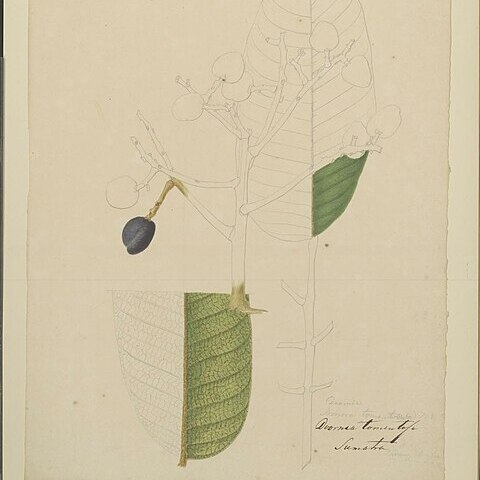Tree, 15-35 m by 20-80 cm, rarely with buttresses, sometimes monoecious? Branchlets 2-15 mm thick, more or less angular, more or less densely woolly pubescent to tomentose, as are the leaves (upper surface of the leaflets excepted), inflorescences and infructescences; terminal bud 0.25-1.75 cm long, subacute. Branchlets exceptionally with some large vascular strands in the pith (SOEPADMO & CHAI S 28154). Leaves 0-4(-5)-jugate. Petioles (1.5-)3-24.5 cm, flattened or channelled at the base to terete. Leaflets ovate to oblong (terminal ones sometimes obovate), 5.5-28(-34) by 2.5-9(-12.5) cm, upper surface glabrous except the midrib (and the bases of the nerves), lower surface woolly pubescent (very rarely to subglabrous); base rounded or one half broadly cuneate; apex gradually to abruptly acuminate; nervation prominent underneath, nerves (9-)l 1-26(-29) pairs (angle 60-80°, in the base up to 90°), usually not arching. Panicles axillary, lax, 2-38 cm, peduncle 0.25-7 cm, branches up to 17.5 cm. Flowers 2-3 mm long. Calyx ½-1 mm high, nearly truncate, outside sparsely pubescent. Filaments adnate to the disk, in male flowers episepalous ones often distinctly longer than epipetalous ones. Disk cupular, fleshy, rim undulate. Pistil in male flowers much reduced. Infructescences up to 22 cm long. Fruits irregularly globular to oblong, 1.25-2 by 0.75-2 cm, stigma less than 90° excentric.
More
A moderate sized tree. It grows 30 m tall. The trunk is 50 cm across. It has buttresses 2 m tall. The bark is grey brown and scaly. The leaves have 1-4 pairs of leaflets. The leaf stalks are hairy. The leaves are oval and 11-27 cm long by 4-12 cm wide. There are 10-20 pairs of side veins and these are raised on both surfaces. They curve and join near the edge. The flowers are hairy and in groups on the axils of leaves. The fruit is round or oblong and 2-3 cm long by 2 cm wide.
Uses. The timber, though not very durable, is used for indoor-construction. The fruits, after being boiled, are eaten; an edible oil is pressed out of the pericarp.


